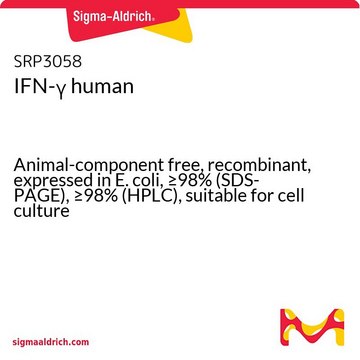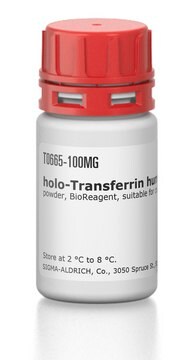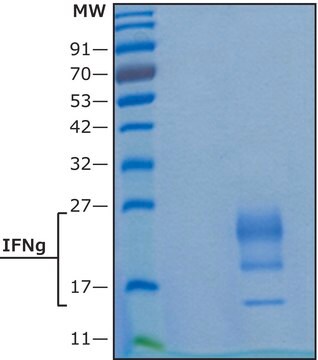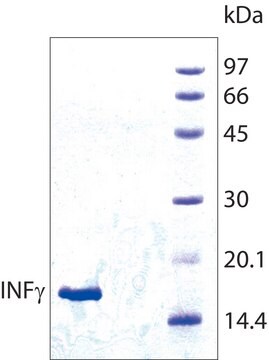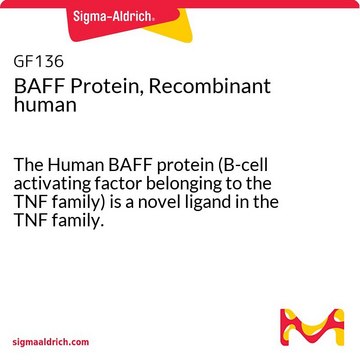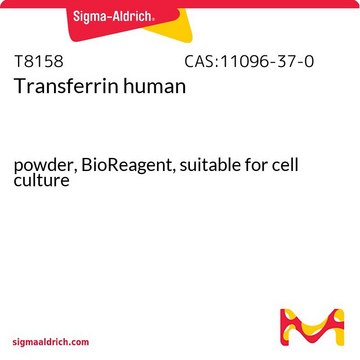SRP3305
BAFF human
Animal-component free, recombinant, expressed in E. coli, ≥98% (SDS-PAGE), ≥98% (HPLC)
Sinónimos:
TALL-1, THANK, TNFSF13B, TNFSF20
Iniciar sesiónpara Ver la Fijación de precios por contrato y de la organización
About This Item
Código UNSPSC:
12352202
NACRES:
NA.32
Productos recomendados
origen biológico
human
recombinante
expressed in E. coli
Ensayo
≥98% (HPLC)
≥98% (SDS-PAGE)
Formulario
lyophilized
mol peso
17.0 kDa
envase
pkg of 20 μg
impurezas
endotoxin, tested
Nº de acceso UniProt
Condiciones de envío
wet ice
temp. de almacenamiento
−20°C
Información sobre el gen
human ... TNFSF13B(10673)
Descripción general
BAFF, a member of the TNF superfamily of ligands, is expressed in T cells, macrophages, monocytes and dendritic cells. BAFF is involved in stimulation of B and T cell function, and is an important survival and maturation factor for peripheral B cells. BAFF signals through three different TNF receptors TACI, BCMA and BAFF-R. The human BAFF gene codes for a 285 amino acid type II transmembrane protein containing a 46 amino acid cytoplasmic domain, a 21 amino acid transmembrane domain, and a 218 amino acid extracellular domain. Recombinant human soluble BAFF is a 152 amino acid polypeptide (17.0 kDa), which contains the TNF-like portion of the extracellular domain of BAFF.
Acciones bioquímicas o fisiológicas
BAFF, a member of the TNF superfamily of ligands, is expressed in T cells, macrophages, monocytes and dendritic cells. Recombinant human soluble BAFF is a 152 amino acid polypeptide (17.0 kDa), which contains the TNF-like portion of the extracellular domain of BAFF.
Forma física
Lyophilized from 20 mM Tris, pH 8.0 + 150mM NaCl.
Reconstitución
Centrifuge the vial prior to opening. Reconstitute in water to a concentration of 0.1-1.0 mg/ml. Do not vortex. This solution can be stored at 2-8°C for up to 1 week. For extended storage, it is recommended to further dilute in a buffer containing a carrier protein (example 0.1% BSA) and store in working aliquots at -20°C to -80°C.
Código de clase de almacenamiento
11 - Combustible Solids
Clase de riesgo para el agua (WGK)
WGK 3
Punto de inflamabilidad (°F)
Not applicable
Punto de inflamabilidad (°C)
Not applicable
Elija entre una de las versiones más recientes:
Certificados de análisis (COA)
Lot/Batch Number
¿No ve la versión correcta?
Si necesita una versión concreta, puede buscar un certificado específico por el número de lote.
¿Ya tiene este producto?
Encuentre la documentación para los productos que ha comprado recientemente en la Biblioteca de documentos.
Rita R Barbosa et al.
Journal of clinical immunology, 34(5), 573-583 (2014-05-09)
B-cell survival and differentiation critically depend on the interaction of BAFF-R and TACI with their ligands, BAFF and APRIL. Mature B-cell defects lead to Common Variable Immunodeficiency (CVID), which is associated with elevated serum levels of BAFF and APRIL. Nevertheless
T J Waldschmidt et al.
Science (New York, N.Y.), 293(5537), 2012-2013 (2001-09-15)
What determines whether transitional B cells newly emerged from the bone marrow will differentiate further to become mature, long-lived, circulating B lymphocytes? In a Perspective, Waldschmidt and Noelle discuss new findings showing that the TNF family ligand BAFF and its
Xiao-Juan Zhu et al.
British journal of haematology, 166(5), 783-791 (2014-06-04)
To investigate the expression of tumour necrosis factor superfamily 13B (TNFSF13B) receptors in immune thrombocytopenia (ITP) and their correlation with disease activity, we investigated the protein and mRNA levels of TNFSF13B, tumour necrosis factor receptor superfamily 13C (TNFRSF13C), TNFRSF13B and
Nuoyan Zheng et al.
BMC nephrology, 16, 72-72 (2015-05-16)
B cell activating factor belonging to the TNF family (BAFF) is vital for B cell survival, proliferation and activation. Evidence indicates that BAFF is systemically or locally increased in glomerulonephritis (e.g. lupus nephritis, IgA nephropathy). However, the effect of BAFF
J Wild et al.
Leukemia, 29(8), 1676-1683 (2015-02-25)
Natural killer (NK) cells are cytotoxic lymphocytes that substantially contribute to the therapeutic benefit of antitumor antibodies like Rituximab, a crucial component in the treatment of B-cell malignancies. In chronic lymphocytic leukemia (CLL), the ability of NK cells to lyse
Nuestro equipo de científicos tiene experiencia en todas las áreas de investigación: Ciencias de la vida, Ciencia de los materiales, Síntesis química, Cromatografía, Analítica y muchas otras.
Póngase en contacto con el Servicio técnico